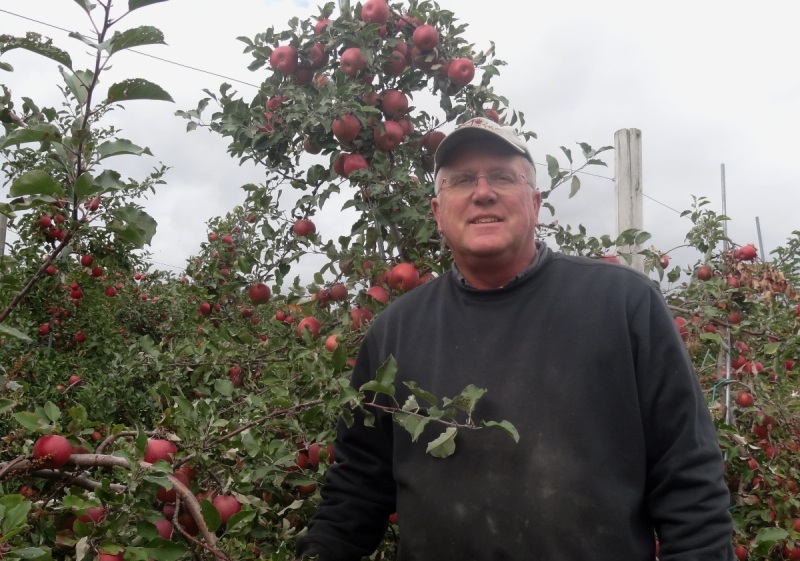
Ralph Waldo Emerson called apples the American fruit. Certainly the legend of Leominster-born Johnny Appleseed, once an orchardist and later a traveler on the frontier planting apples, is one of our favorite American stories. However, archeologists have found European fossil evidence of apples growing in prehistoric times. Apples had a long history before they ever made it to America. These early apples were actually very tiny crab apples. Evolution carried on its slow work over the eons.
The Greek poet Homer, possibly born around 850 B.C., mentions apples in The Odyssey, and Plutarch wrote about a fictional banquet where the discussion turned to the apple. One of the characters said the apple was a perfect fruit because it was smooth to the touch, had a sweet flavor and fragrance, and appealing to all the senses.
More pragmatic reasons could be named for its perfections. It will grow in cold parts of the world, and it can be cooked, eaten fresh, or stored for long periods of time without any preservation. It can also be dried for later use, and it can be turned into hard cider, or applejack which is a distilled cider, a kind of brandy. It means that apples can be eaten, or drunk, during several months of the year. Of no other fruit is this true.
Long before Emerson came on the scene, cider, and I do mean hard cider, was a common drink for everyone in the country. Although those early settlers had good clean water in this country, they came from places where the water was not good. They knew that many diseases were caused by water even though they did know exactly why or how. In any event, they were cautious about water, and careful in their preservation methods when making hard cider.
The apples that made that cider were not eating apples as we know them. Apples are a fruit that rarely grows true from seed. We all know that Johnny Appleseed went around planting apple seeds, but he was not interested in eating apples. He wanted cider apples, and the best cider is made with many different kinds of apples. Since apples did not grow true from seed a seed planted orchard was by definition an orchard of many different types of apples.
Hard cider and applejack remained important alcoholic drinks right into the 20th century until Prohibition was declared. During those years whole orchards were cut down to prevent the making of cider. By the time Prohibition was repealed people had pretty much forgotten about cider, and the orchards were gone. Happily, today there is a resurgence of interest in hard cider, an interest we can see right in our own neighborhood with the success of farms like West County Cider.
Once in a while a seed apple would turn out to be a good eating apple. One of these is Northern Spy.
Other good eating apples that appeared by chance were then propagated by grafting. Small twigs, called scions, of the desired tree would be grafted onto another tree that grew well in that area. By the 1500s books explaining how to graft apples were written. It is through grafting that today we can even order up an apple tree that bears three different types of apples.
By the turn of the 20th century L.H. Bailey compiled a list of 878 apple varieties in cultivation. There may have been some duplicates in that list, but we all know that that only about a dozen varieties are available in the supermarket today. What happened?
There are many reasons from cities getting bigger, farms being located farther from the cities and the introduction of large controlled cold storage buildings. Since farmers could now transport their apples long distances they began to grow only the most dependable and heavy bearing apples.
Also over the years people’s tastes changed. People wanted red apples and hence the development of Red Delicious. People wanted ever sweeter apples and so those apples with more complex flavors fell off the list.
In recent years there has been more and more interest in the old varieties. Tower Hill Botanical Garden has an heirloom apple orchard where 119 pre-20th century apple varieties grow. We are also fortunate that our local orchards sell the apples that have long been familiar in the supermarket, but they also grow and sell some of the antique varieties like Gravenstein, Jonathan, Rhode Island Greening, Roxbury Russet, Winesap and others.
Of course, new apples are being developed all the time. Honey Crisp certainly comes to mind and this sweet, crisp apple is much in demand.

We planted the Liberty apple in Heath because it was hybridized for disease resistance and was introduced in 1978. I didn’t want to have to worry about spraying and we have had good crops with very little work. The apples are clean, beautiful and with good flavor.
I love driving by orchards and this year the harvest is particularly good. I stopped to see Tim Smith at Apex Orchards where his trees are bent with thick set fruit. Even my Liberty tree is more heavily laden than usual. Pine Hill Orchard and Clarkdale are enjoying a similar happy harvest this year.
When I was growing up my father ended every dinner with an apple. I continue the tradition of eating a lot of apples over the course of the year, but I confess a number of them will be eaten in apple pan dowdy (makes your eyes light up and your stomach say howdy), apple crisp, apple pie and apple cake. Yes, indeed. The apple is a versatile fruit.
Between the Rows October 17, 2015
Watch for CIDER DAYS November 7 & 8 at the various orchards and venues.
My favorite apple used to be Cortland, but now I am hooked on Honeycrisp. I prefer eating them as is as opposed to cooking with them, but I wont’t refuse a good dessert.